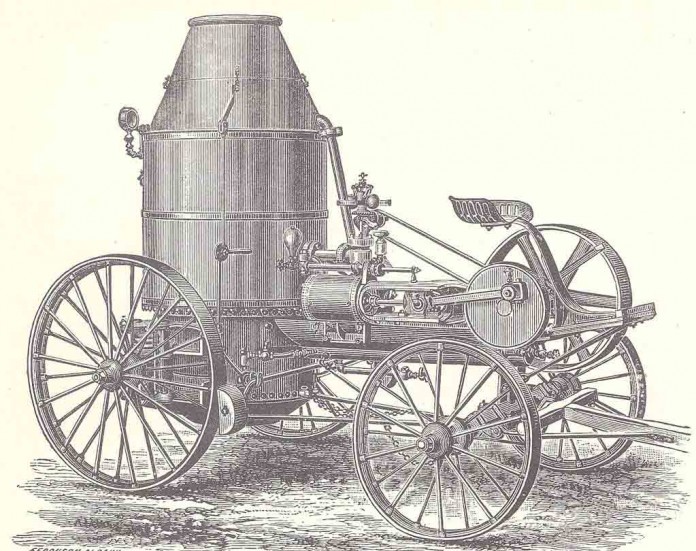
A good many years ago, I put together for another publication a list of what I consider to be the most significant new developments in agricultural machinery during the 19th century and the first half of the 20th.
One or two of them can be attributed to a single individual, but most were the product of many curious and ingenious people who made incremental improvements to the work of their predecessors.
The following are the first five of my list. The rest will be in the next column — so read them over and let us know what you think of my choices.
1. The cotton gin
In colonial times, cotton cloth was more expensive than linen or wool, due primarily to the extreme difficulty of separating the seeds from the clinging fibers.
One man could pick the seeds from only about one pound of cotton fibers per day. Then in 1793, Eli Whitney built a machine consisting of a row of close-set wheels with saw-like teeth around their perimeters. The wheels protruded through narrow slits between metal bars into a hopper filled with cotton bolls.
As the wheels revolved, the teeth caught the cotton fibers and pulled them through the comb-like slits, which were too narrow for the seeds to pass, thus separating the two.
Whitney’s cotton gin allowed a 1,000 pounds of cotton to be cleaned in the time it took one man to do five pounds by hand. As a result, cotton cloth became cheap, the cotton plantation culture of the South was established, and the use of slave labor in growing cotton became entrenched.
2. The reaper/binder
Small grains had been harvested by hand for centuries — cut with sickles or scythes and then raked and tied into sheaves by hand. Grain harvesting machines first appeared in Great Britain about 1800, and a decade or two later in the U.S., but most failed.
Obed Hussey and Cyrus McCormick both developed successful reapers during the 1830s (and battled in the newspapers and courts for years over which of them was first).
McCormick’s machine became the more popular and he is credited with inventing the reaper.
These early machines still required the sheaves to be gathered up and bound by hand by people following on the ground, but in 1857, the Marsh brothers equipped a reaper with moving canvases that carried the grain to a platform where it was tied into bundles by someone riding on the machine.
In 1867, the first twine knotter was demonstrated by John Appleby. Sylvanus Locke developed a wire binder about 1874, which was adopted by McCormick. Wire dominated for a short while, but bits of wire got into the grain and ended up in livestock and flour, with disastrous results.
William Deering adopted the twine-tying mechanism for his popular Deering harvesters and about 1881, McCormick followed suit.
3. The thresher
When grain was being cut by hand, the method for separating the kernels from the straw was slow and labor intensive. Grain was hauled to a barn where it was spread out on a threshing floor and either beat with hand flails or trampled by animals.
This knocked the kernels free of the straw, which was then raked away. The remaining mixture was winnowed by tossing it into the air, where the wind was relied upon to blow the chaff and lighter debris away from the heavier grain, which fell back onto the threshing floor.
The first threshing machine with a revolving, toothed cylinder and concaves was invented in 1786 in Scotland by Andrew Meikle. In 1830, brothers Hiram and John Pitts are credited with the first successful American separator, as well as with adapting a horse tread power to run the thing.
4. Steam engine
For centuries, farmers relied primarily upon water power or the strong backs and arms of themselves, family members, hired men, or slaves with help from oxen and horses, but the new farm machines being developed in the 19th century required more power.
Stationary steam engines were used early on to run cotton gins and mills. The additional power required by the improved threshing machines led to the development of portable steam power, which made its first appearance in 1849.
At first, portable steam engines were pulled from place to place by horses. During the 1870s, several inventors developed practical drive systems and the self-propelled steam traction engine became common as power for the many threshing rigs around the country.
They were also used for pulling multiple gang plows in the large fields of the wheat belt. By the 1920s, the steam traction engine’s day was over, replaced by lighter and more maneuverable kerosene and gasoline powered tractors.
5. Combined harvester-thresher
Although a “traveling thrasher” or combined harvester-thresher, had been patented as early as 1828, the first successful machine was built by Hiram Moore in 1834.
Moore’s combine successfully cut and threshed grain, although it had to be winnowed later. After the Civil War, big horse-drawn, ground-driven combines were developed in the wheat growing regions of the northwest.
In 1871, B.F. Cook put a steam engine on a combine to drive the mechanism, making it possible for fewer horses to pull. About 1886, a California farmer named George Berry built a combine around a steam traction engine and voila — the first self-propelled combine!
Other choices
The rest of my choices will be in the Aug. 11 issue of Farm and Dairy, so don’t miss it. On July 16, I attended the Ride Through History military show that’s put on every year near Alliance, by the Marlboro Volunteers.
It was very interesting and informative and gives one a glimpse of the U.S. Army’s experiences from the War of 1812, through Afghanistan and Iraq. I highly recommend you put it on your calendar for next year, and take the kids!












